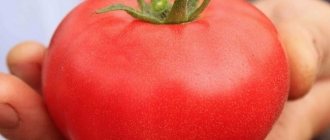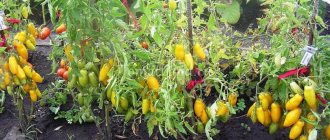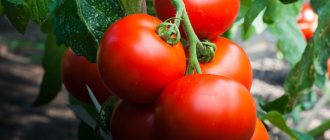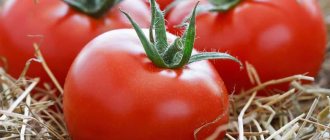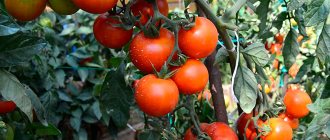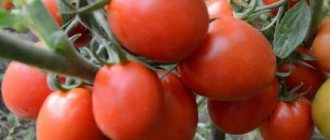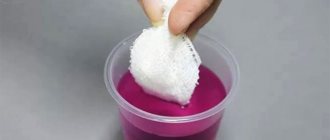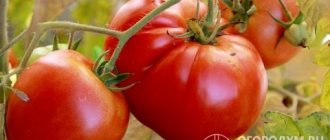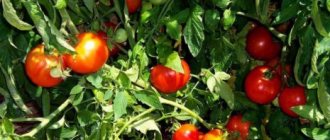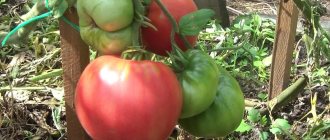| Ripening period: | early |
| Shape, weight of fruits: | flat-round, 80-110 g |
| Bush type: | determinant |
| Growing regions: | III, IV light zones |
| Productivity: | 5-5.5 kg per bush |
For more than two decades, one of the best greenhouse hybrids has been the Blagovest F1 tomato. It is productive, ripens early, but needs careful care. The fruits are beautiful, shelf-stable, with excellent commercial qualities, although some consider their taste to be bland. Despite the fact that Blagovest is not ideal, it continues to be the “workhorse” of indoor soil, and is not going to give up its position to new varieties or hybrids.
Planting scheme
A rectangular box or other container for seedlings is filled with a substrate that is suitable for seedlings. On moistened, evenly saturated soil, seeds are laid out 2 cm from each other and sprinkled on top with a thin layer of soil. The seed placement depth is no more than 150 mm. The seeds of hybrid plants are initially treated against diseases and pests, so they can be sown dry or with additional treatment with agents to stimulate growth.
After 7 weeks, the seedlings can be transplanted into a greenhouse, which can be either film or glass. At this point, the soil should be prepared (dug up and fertilized, at a depth of 10-12 cm, the soil temperature is 12-14°C). Before transplanting seedlings into the greenhouse, you need to water the plants so as not to damage the roots.
Transplantation is carried out as follows: a hole is dug, seedlings are removed, installed vertically in the planting hole and sprinkled with earth, after which the soil should be compacted and watered. If the seedlings are overgrown, the plant should be laid on its side so that part of the trunk remains in the ground. The bushes should be planted at a distance of 40 cm from each other, the width between the rows should be about 50-60 cm. The planting density is 3 bushes per square meter.
Fruit characteristics
- The shape of Blagovest tomatoes is round, smooth, slightly compressed at the stalk and tip.
- Unripe tomatoes are white-green in color, turning bright red as they ripen.
- The average weight of the fruit is 120 g, under favorable conditions it can increase to 150 g.
- The pulp is dense and juicy.
- The taste is sweetish and slightly sour.
- The skin is dense and does not crack.
- It has 2-3 seed chambers, which contain many seeds and little juice.
- Dry matter content about 5%.
- They are resistant to long-term transportation, so they are often cultivated on an industrial scale.
Important! The characteristics of Blagovest tomatoes depend on agricultural technology: sugar content depends on lighting, wateriness depends on the frequency of watering.
Growing and care
Tying to a support and pinching are necessary manipulations for the Blagovest variety. For gartering, vertical trellises (lattice structures) are used: first, the strengthened seedlings are tied at the base, and then the growing trunk is sent up the rope. A feature of the variety is its ability to self-regulate growth: when the bush reaches one and a half meters in height, it forms an inflorescence at the top - its further growth stops there. If the height of the room allows the bush to grow further, then a new top can be formed from the best top shoot.
The plant should be formed into 1 or 2 stems. In the first option, it is necessary to remove the side shoots that grow from the axils of the leaves, in the second, leave 1 stepson under the first flower cluster.
This variety is not afraid of drafts, and therefore the greenhouse can be open from morning to evening, but it must have moderate air temperature and moderate humidity. Depending on weather conditions, plants are watered with warm water once every 7-10 days, after which the soil is loosened and weeds are removed.
Once every 15-20 days after watering, complex fertilizers, in particular superphosphate and potassium fertilizers, should be used. 10-15 days before harvesting, fertilizing must be stopped.
Description and characteristics of the variety
- Hybrid, as indicated by the sign on the package of seeds “F1”. It will not be possible to grow such tomatoes and seeds collected on your own, since they do not retain the tomato qualities of the variety. Fans of the Blagovest variety have to buy new seeds every year.
- Early ripening period. After emergence, the first ripe fruits can be removed from the bush after 95-105 days.
- The root system is superficial, well developed and branched in width.
- The bush is determinate, non-standard. It reaches a height of 150-180 cm. At this point, its growth stops on its own.
- Designed for growing in greenhouses. When planted in open ground, few fruits are set, and in the northern regions there are practically none at all.
- These are tall bushes, so as they grow, you need to tie the stems to a support or trellis at the very top.
- The leaves are large, dark green, slightly pubescent.
- The flowers are small, bisexual, forming 7–8 clusters on the bush. 6-8 tomatoes are formed on 1 brush.
- The shoots are long and spreading.
- The fruits ripen at the same time.
- Resistant to many diseases typical of nightshades.
- Important! Pruning must be carried out on time, since lateral shoots impair the yield and prolong the ripening period of the fruit.
- The productivity is high; from 1 bush, when formed into one stem, about 5-6 kg of tomatoes are harvested.
Important! Productivity can be increased if you shift the growth point of the bush from the central to the side shoot.
Review Reviews
Most of the reviews for the Blagovest tomato are positive. Gardeners note the increased productivity of this variety (until late autumn), high resistance to various diseases and pests, rich beautiful color and identical weight and size of ripe fruits, as well as their taste, which are equally good both fresh and in in the form of canned food, juice and sauces.
Buyers pay attention to the fact that it is possible to achieve the manifestation of all the distinctive characteristics of Blagovest only if it is grown in closed greenhouses - in open ground the quality of the crop is much worse.
Blagovest tomatoes on video
It is not worth taking seeds from this tomato, since it is not a variety, but a hybrid.
If you grew Blagovest f1 tomatoes, please write in the comments what the yield and taste of the fruit were in your climatic conditions? How do you rate the disease resistance of this tomato? Briefly describe the advantages and disadvantages, evaluate the taste. If possible, attach to the comment a photo of the entire bush as a whole or individual fruits that you grew. Thank you!
Your reviews of the Blagovest tomato and additions to the description will help many gardeners evaluate this hybrid more objectively and decide whether it is worth planting or not.
Temperature and watering
It is necessary to monitor the temperature regime and prevent the plants from overheating. To do this, on warm days the greenhouse must be ventilated. If the weather is very hot, then you can lay out a white non-woven fabric on the roof of the greenhouse.
Important. The sugar content of fruits is affected by a sufficient amount of sunlight. If there is not enough of it, the tomatoes will be sour. Watering should not be excessive, otherwise the tomatoes will turn out watery.
Advantages and disadvantages of a hybrid
The main advantages of the Blagovest F1 tomato:
- early maturation;
- high productivity;
- the fruits are beautiful, even;
- resistance to a complex of diseases;
- universal use of fruits;
- good keeping quality and transportability of tomatoes.
Among the disadvantages of the hybrid:
- forming a bush requires certain knowledge and skills;
- Blagovest is not intended for cultivation in open ground conditions;
- insufficient resistance to pests;
- the hybrid reveals its full potential only in light zones III and IV;
- the need to tie up the bush.
Sometimes they indicate that the taste of Blagovest tomato is not good enough. But he's not bad at all. And it is generally wrong to compare the taste qualities of open-ground and greenhouse vegetables. The latter will always lose.
Tomato care
Like any other variety, Blagovest needs regular watering, fertilizing, gartering and disease prevention. With careful care and sufficient fertilizer, the variety gives a good, high-quality harvest.
Watering
Watering should be regular, the best time is early morning or late evening. The water should be warm. The soil should not be allowed to dry out, but excessive moisture can also be harmful.
It is best to water the plants as the top layer of soil dries, but at least once every 3 days. During the period of active fruiting or in hot weather conditions, it is necessary to water the bushes more often.
A drip irrigation system is best suited for a greenhouse; it will not allow the soil to dry out and will maintain the required level of humidity. After each watering, it is necessary to ventilate the greenhouse to eliminate excess air humidity and loosen the soil so that oxygen penetrates better.
Top dressing
Tomatoes need both mineral and organic fertilizers. It is better to fertilize once every 2-3 weeks; the last fertilizer should not be later than 2 weeks before the expected harvest.
Inspect your plants regularly for signs of disease and pests. The sooner you find it, the better the outcome for the bushes.
What you can feed:
- Phosphorus-potassium mineral fertilizers (ash, potassium sulfate);
- Boric acid;
- Animal droppings;
- Nettle humus;
- Yeast fertilizers;
- Bread solutions;
- Whey.
Tying tomatoes
To prevent the stems from breaking and bending to the ground under the weight of their own fruits, the bushes must be tied up. Even if the branch does not break off, lying on the ground they will interfere with watering, and the fruits will acquire worms and slugs.
It is best to prepare pegs immediately before planting the seedlings. Then, during growth, the tomato branches will wrap around the support.
Often during gartering, you can damage the branches or root system of the plant, so this should be done carefully, at an earlier stage of formation.
In order not to transfer last year's infections to plants of the new season, it is recommended to use new ribbons, not last year's ones.
Under no circumstances should thin wire, fishing line or rope be used for gartering. Nylon stockings or tights, fabric ribbons and straps are best suited. You should tie it up gently; you should not pull the bushes with ropes, as this will prevent them from fully growing and developing.
Nuances you need to know when growing Blagovest tomatoes
There are several recommendations for cultivating this varietal variety:
- The best method for growing this variety is using seedlings.
- To prepare the optimal soil for seeds, you need to mix purchased soil - a mixture based on turf and humus. The elements are mixed in equal proportions.
- To improve the quality of the soil for seeds, you can add peat or sawdust.
- To grow better before planting, they can be soaked in warm water for a day.
- It is better to sow seeds in late winter or early spring.
- The holes usually do not exceed a depth of ten millimeters.
- There should be a distance of about twenty millimeters between the seeds.
- After you have placed the seeds in the hole, they need to be covered with soil and watered.
- If the average temperature in the room in which the seeds are grown is approximately twenty-five to twenty-seven degrees, then after forty-eight to seventy-two hours, the first shoots will already begin to appear. If the temperature is below twenty-five degrees, the sprouting process takes about a week. Yes, transplanting seedlings directly into the greenhouse should take about five to six dozen days.
- The seedlings should grow to a height of twenty centimeters, and the shoots should have approximately six leaves.
- Forty to forty-five days after the first shoots appear, the plants must be hardened off.
- The hardening process means that the plants must be taken outside, but for a short time and gradually every day the time in the air should increase.
- The ideal planting method is in a staggered pattern, but can also be planted in parallel rows.
- There should be no less than one hundred and forty to one hundred and fifty centimeters between the bushes. These are optimal conditions for growing good quality tomatoes.
- There should be a distance of at least a hundred centimeters between the rows. These are optimal conditions for growing good quality tomatoes. It should be taken into account that the grade is quite high.
- To plant seedlings, you will need holes about twenty to twenty-two centimeters deep and wide.
- Whether you will transplant the seedlings into open ground, this can only be done after the night frosts have completely ended and a warm average temperature has established both day and night.
- It is not recommended to plant the Blavest variety in open ground, as it shows worse yields; if you are going to do this, then this can only be done in the south of our country.
- The rules of crop rotation state that the best place for planting blagovest tomatoes is the land on which onions, garlic, legumes or cucumbers previously grew.
- There is no need to plant tomatoes after potatoes, eggplants and other types of tomatoes. This violates the rules of crop rotation and can lead to negative consequences.
- For Blagovest tomatoes, a well-lit place is important; special attention must also be paid to this.
- Also, bushes do not like windy places.
- To prevent the plants from getting sunburned, you will need to place an awning over them.
History of selection
Tomato Blagovest F1 was created by Gavrish Breeding Company LLC and entered into the State Register in 1996. The hybrid is protected by a patent that expires in December 2028.
The Blagovest tomato is intended for cultivation in the Central and Volga-Vyatka regions.
Growing regions
Blagovest can be cultivated in central Russia. This variety also produces good results in the Volga-Vyatka region. Therefore it is recommended for:
- Moscow region;
- Tula region;
- Kaluga region;
- Kirov, Nizhny Novgorod regions;
- Mordovia and Chuvashia.
Similar hybrids
Blagovest tomatoes are similar in characteristics and descriptions to the following hybrids for growing in greenhouses:
- Verlioka F1;
- Impala F1;
- Leopold F1;
- Nadezhda F1.
They all form a bush about 1.5 m tall, which leads into 1-2 stems. The fruits are early ripening, flat-round, red, weighing 80-120 g.
How to grow properly
The Blagovest tomato is grown in seedlings. Seeds are sown in boxes or special pots. The soil for seedlings must contain a fertile base. When the plant reaches the age of six to seven weeks, it needs to be transplanted to a permanent place in the greenhouse.
When planting seedlings, it is worth considering that an adult plant will be tall and spreading, so it is recommended to plant no more than 3-4 plants per square meter. For good growth, the soil must be highly fertile - it must be fed with potassium and superphosphate fertilizers (3-4 times per season), and regularly loosened.
The Blagovest tomato was bred for closed ground; it will grow and bear fruit well in glass and film greenhouses. This heat-loving plant in open ground will not give a good harvest.
Diseases and pests
Tomato Blagovest F1 is characterized by complex resistance to the following diseases:
- fusarium;
- tobacco mosaic;
- cladosporiosis.
Other diseases, in particular rot and late blight, are affected at the level of conventional hybrids. Preventative treatments with fungicides and regular ventilation of the greenhouse are needed.
Blagovest is moderately affected by pests. The greenhouse must be periodically inspected for their appearance and treated with insecticides.
